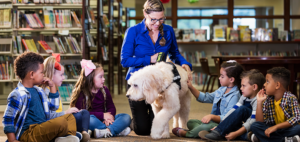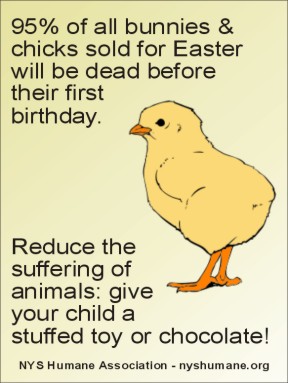Article:
Humane Education Can Change Lives
On the first day of school, the need for humane education is evident for many teachers and their students. One of our Board members, a former educator, remembers all too well students coming into her room crying because their prized and pet cows were just auctioned off at the local county fair even after winning blue ribbons.

These students were connected to their animals and clearly open to learning about caring for and about them for non-commercial reasons. The problem? Humane education, though mandated by NYS law in elementary schools, is not taught unless an individual teacher finds a way to fit it into the curriculum. There are very simple and easy ways to incorporate lessons about animals and the environment into lesson plans, and many can be found on our website. As a matter of fact, one of NYSHA’s goals has been to promote humane ed but we have met with little success with the NYS Department of Education, although we will continue to try.
Humane education is an important concept that can teach children compassion, respect, and empathy for the Earth, the environment, for each other, and for all living beings. It can be a key factor in countering the highly negative influences that bombard children every day, whether it is violent TV or video games, bullying they encounter or experience themselves, or disturbing news coverage concerning local and global events. Children have a natural love of and curiosity about animals and teaching them that animals have needs, wants, and emotions just like they do is a powerful lesson that carries over into their treatment of each other and their future pro-social life.
There are many ways to introduce humane education, including expert guest speakers, visual aids, games, and books and brochures. NYSHA members have decades of experience visiting schools and introducing children to topics such as wildlife, factory farming, environmental issues, marine life and ocean well-being, zoos and circuses, taking care of dogs and cats, global warming, rain forest preservation, and the effect of diet on their health, all presented in a way that emphasizes respect and the value of all life. The COVID pandemic that began in 2020 has made visits by guest speakers more difficult but doesn’t affect teacher involvement.
 The most effective method for fostering humane education is for teachers to incorporate it as much as possible into their class curricula, since children spend many hours each day at school and the teacher is a role model and authority figure. There are many organizations set up to help in this task by providing humane education programs for all grades K -12, and NYSHA has links to many of these on its website (see pages NYSHA’s Humane Education Materials and NYSHA’s Resources for Teachers and Classroom Presenters).
The most effective method for fostering humane education is for teachers to incorporate it as much as possible into their class curricula, since children spend many hours each day at school and the teacher is a role model and authority figure. There are many organizations set up to help in this task by providing humane education programs for all grades K -12, and NYSHA has links to many of these on its website (see pages NYSHA’s Humane Education Materials and NYSHA’s Resources for Teachers and Classroom Presenters).
Humane education is easily incorporated into classroom topics, and examples from the animal and environmental world tend to pique children’s interests. A popular example in math education involves pet overpopulation and the value of spay/neuter. Have student calculate how many cats will be born in a given period of time, if one male and female pair of cats can have 2 litters per year with 6 kittens each, half of which are female who can have their own litters after 6 months. It will become apparent that there aren’t homes for them all.
Besides schools, libraries and adult centers can also incorporate humane education into after-school children’s’ programs and evening adult presentations. NYSHA is looking into these as possible venues and is also working with other large national organizations and local animal-oriented groups. Since NYSHA has several educators on its Board, anyone interested in this critical means to protect animals can contact us for suggestions, ideas, or guidance.
Remember — humane education can take place anywhere. Let your local news station producer know why their coverage of the Saratoga horse races is offensive and insensitive, explain to a neighbor why her outdoor cat should be indoors, put up a turtle crossing sign along a road, invite children (and adults!) to meet your rescued donkeys, bring grandchildren to animal sanctuaries and wildlife refuges instead of a zoo. We can, and should, all be teachers in our daily lives to shape current and future attitudes toward the creatures whose world we share.
New York State Humane Association Humane Review, Vol.XL Fall 2022.